Many people may argue that you cannot carve wood without tools. It is not true. It is possible to carve wood without tools and in this article, we will show you exactly how to carve wood without tools.
For tool-free wood carving, you can make a lathe from items you already have around the house, or attach woodworking pieces to the drill and use it as a router. If you don’t have a carving tool, you can modify things like a Swiss Army knife, butter knife, or razor blade to work like a paring knife.
Do not use kitchen knives as wood carving tools, as they will not work well and will be dangerous for you.
If for some reason you do not have access to wood carving tools, or you prefer and believe that you can better design a tool that fits your taste and project specifications, this article is for you.
Plus, you get the fun and knowledge of making your own wood carving tools from start to finish. Now we show you how to carve wood without tools.

- What do you need to know before you start wood carving?
- Types of wood carving
- 1. Whittling
- Five slices used in planning
- Push cut
- Pare cut
- Stop cut
- V-cut
- 2. Chip carving
- 3. Relief carving
- 4. Pyrography
- 5. Round thread
- What can I use to carve wood?
- Wood carving tools for beginners
- Carving knife
- Wood carving chisels and mallet
- Can I make my own wood carving tool?
- How to make a carving knife
- Materials
- Tools
- Method
- How to make a mallet
- Materials
- Method
- Safety tips for making carving tools
- FAQ
- What can I use if I don’t have a knife for my carving?
- Can you use a knife to carve wood?
- Is wood carving difficult to learn?
- Which wood is better for carving?
- How long does it take to learn how to carve wood?
- What should I cut as a beginner?
- What is the easiest thing to carve in wood?
- Conclusion
What do you need to know before you start wood carving?
I know you are excited to start wood carving your first project. But before that, as in any other field, you need to know a few things.
Here I mentioned that you should know that you have to practice before starting wood carving they are:
Choosing the right wood. Knowing the right blade for the perfect result saves you time and increases your desire to learn more. Therefore, it is important to choose the right wood before you start carving.
Choosing the right Tools. Never spend money on unnecessary things until you know how and when you’re going to use them. There are woodworking tools that can be used for multiple tasks. Most importantly, you should have a clear idea of what tools you really need and how to use them.
Always follow a plan. Before you start carving, make your own or download one from the internet. There are many examples of wood carving. You must specify the dimensions and location of the cuts. So, take a piece of paper and a pencil and start by drawing a map.
Wear gloves. Safety is important when wood carving. You have to work with machines, wood carving knives, chip carving, cutting and cleaning tools, and many other hard, sharp metal objects.
So make sure you always use gloves for both hands. If you’re a pro at wood carving games, there’s a certain point where you can do things without gloves to get those fine details that are hard to get to with gloves. But until then, wearing gloves is a must for beginners.
Mandatory sanding. No matter what wood you want to cut, sanding is important. By sanding you can avoid many problems such as cracks, dents, dirt, and surface slip. So before you start wood carving, sand the surface with fine sandpaper.
With full knowledge of all the above factors, one can easily learn the tricks and wood carving techniques of inlay.
As a beginner, I focused on these things before I started wood carving.
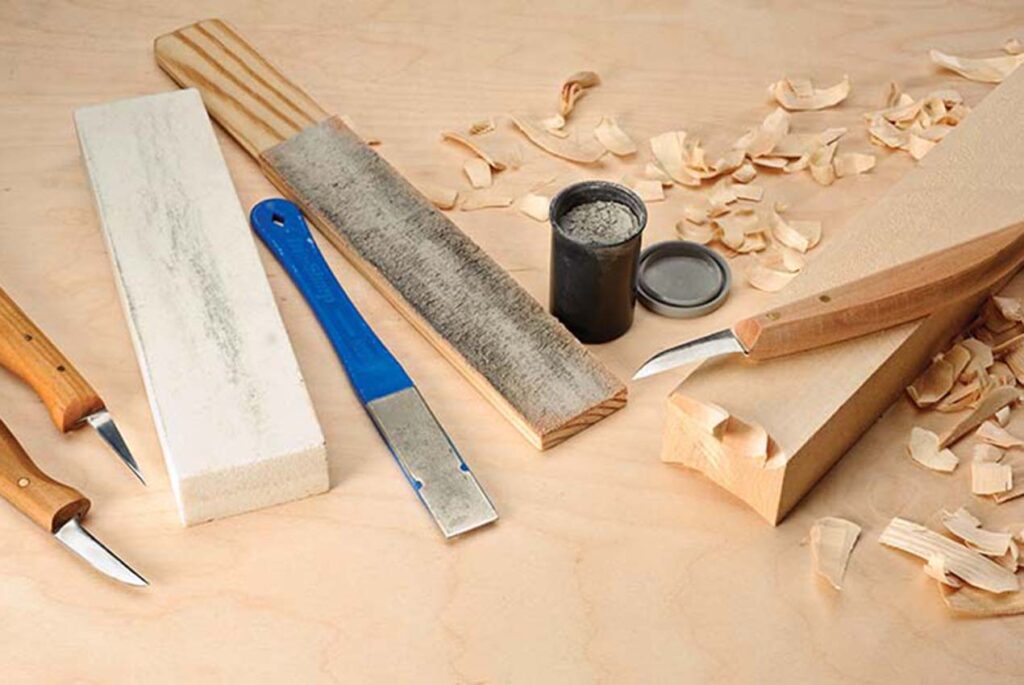
Types of wood carving
1. Whittling
Whittling is what most people think of when they think of carving wood. Carving is the art of wood carving using a carving knife. And here is the best pairing knife I recommend.
Traditional planning requires no other hand tools, not even chisels, chisels, or V-tools, and certainly not power tools.
Also, sandpaper should not be used during planning. When you finish the wood carving, you can see the effect of the knife.
While technically, any knife can be used for this type of wood carving, nothing is quite like a paring knife. These tools either have a fixed handle like the Beavercraft Slide Knife or a folding pocket knife like the Flexcut Lifter.
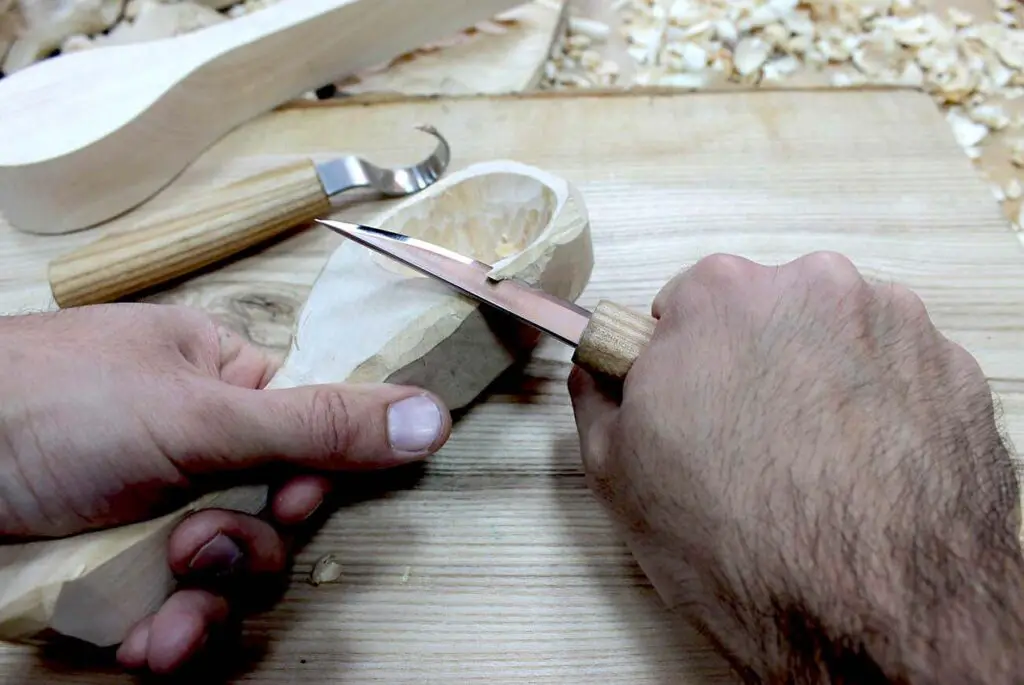
Five slices used in planning
Cut immediately
This is the first step in any wood carving project and involves careful scoring to remove excess wood and maintain the shape of your design.
For this, hold the stick firmly in your hand and make long cuts outwards (away from you) with a firm hand. You will get the best results if you cut the grain.
That’s why it’s called rough because you’re not trying to smooth the shape yet.
Push cut
Like a straight rough cut, this is a body blow. However, the thrust cut has more control. Instead of using your wrist to move the knife, place the blade where you want to cut and apply pressure with your other thumb.
So if you have a paring knife in your right hand, press the blade with your left thumb. The push cut is also called a levering cut or push-away cut.

Pare cut
Steam cutting, also known as stretching, involves the same technique as peeling an apple or potato with a knife. This is the most common slice used in planning. However, because you are pulling the knife towards you, you need to be careful and have more control over the design.
Stop cut
A stop cut is when you cut a deep line through the wood to prevent a push or pull cut beyond it. This is usually used after rough cutting when you need precision.
V-cut
It’s like a stop cut because there’s a fixed point you want to get to, so you cut up to an imaginary point and then bring it down and make a V shape.

2. Chip carving
Chip carving is an ideal niche for beginners. Using soft wood and a good old chisel with small notches, you can create an interesting and eye-catching design.
Chip carving is mainly used for decorative purposes. Chip carving is also great for picture frames, cabinet designs, or other workbench work.
Planning is for shapes and cutting is for drawings. However, both types are ideal for beginners.
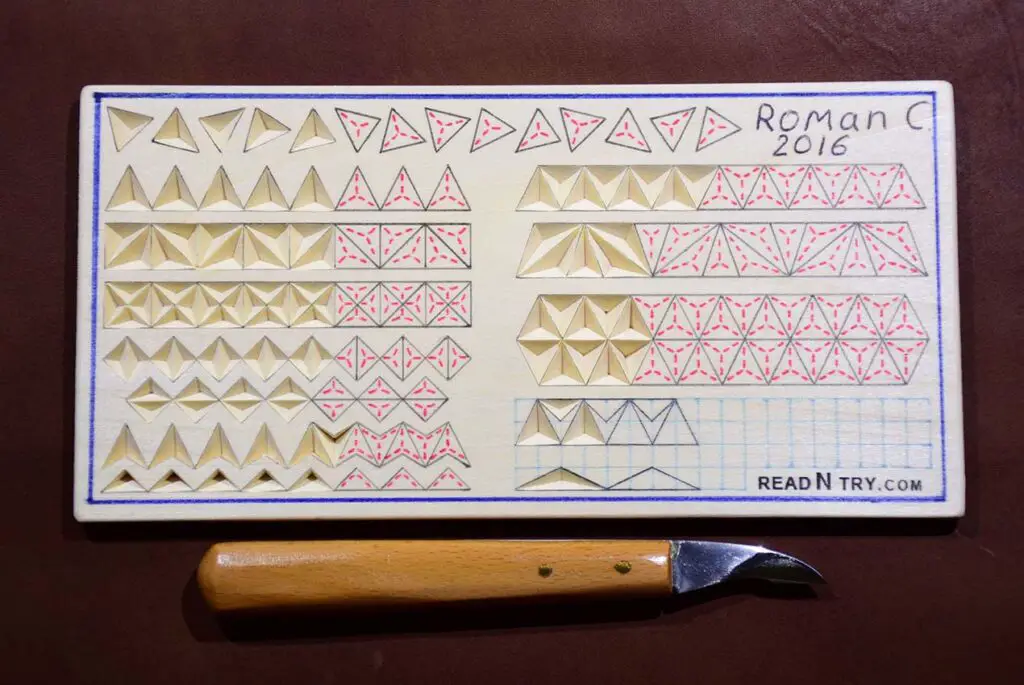
3. Relief carving
We move into more difficult territory and have outstanding wood carving. Relief carving- in this wood carving technique, a pattern is carved from a flat backing board so that the object appears to float above the piece of wood.
So instead of relief carving around the wood, you cut it and create a three-dimensional shape. Raised engraving is like engraving on steroids. Instead of straight lines and smooth chips, you have deep grooves and lots of curves.
Embossing is divided into two main categories: embossing and low embossing. Each relates to the depth of the carving – low relief is up to ½ inch, while high relief carving is slightly more.
However, some people recommend deeper than 2 inches. Depending on the size of the project or the depth required for drilling, wood carving tools can be useful.
The most common wood carving tools are gouges, chisels and mallets, and the V tool. Relief carvings are usually used for decorative figures, scenes, and caricatures.
Although there is no specific cut, relief carving is highly dependent on one’s ability to hold and manipulate various wood carving tools.
So if you want to become an expert in relief wood carving, you may need to master some of these other techniques first, especially the next one on our list.
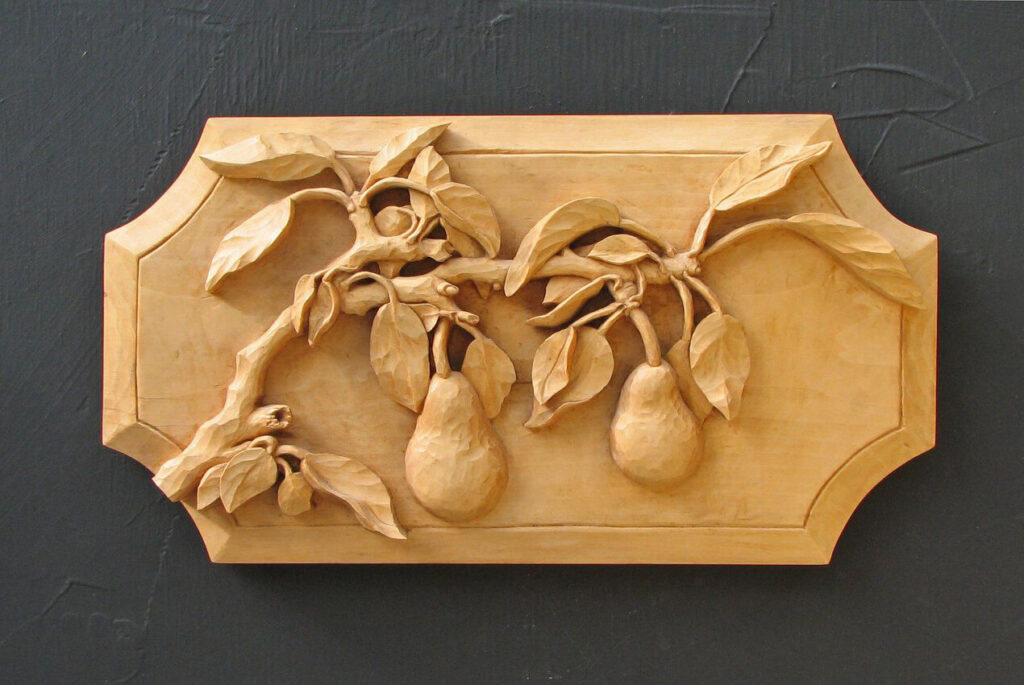
4. Pyrography
Pyrography is a type of wood carving engraving used to decorate wood with handprints. Pyrography is also considered writing with fire.
This wood carving is done with a heated pen and the results are impressive. With a good pyrography kit, you can create beautiful patterns with amazing textures.
Pyrography is also great for wood carving beginners and is very creative.
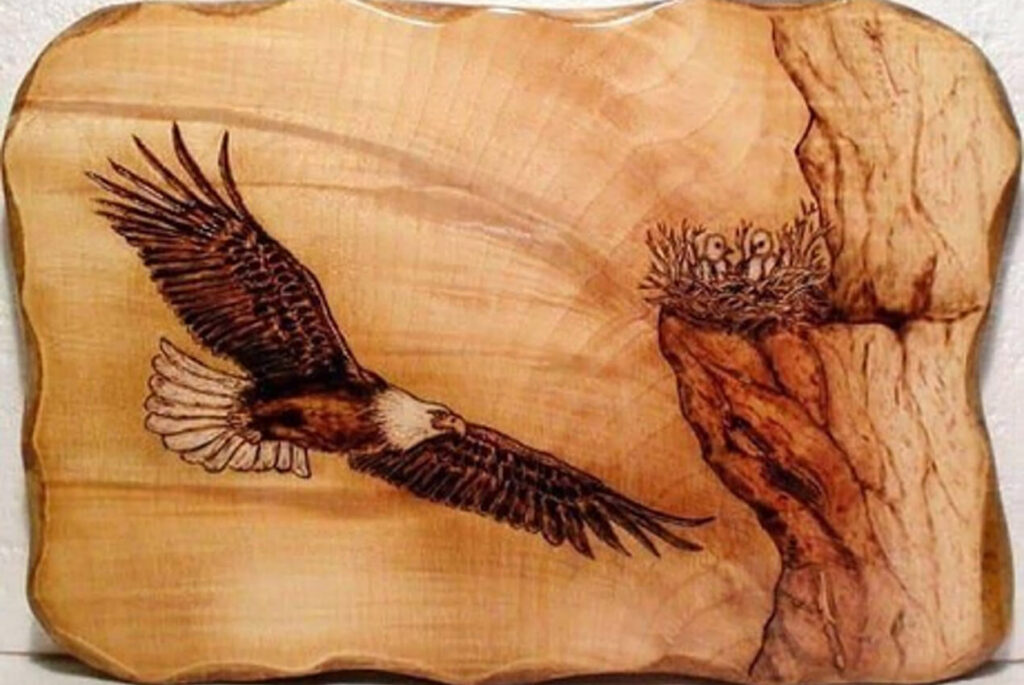
5. Round thread
Circle carving refers to a wood carving 3D completed project in which a piece of wood is cut to create realistic designs.
This type of insert requires a more delicate finish that may include painting, staining, or even baking. This style of carving is smoother and more detailed than carving and does not have a flat back like relief wood carving.
To achieve this look, circular carving uses more tools and different sizes than other carving techniques. Power tools may also be required to fine-tune some items.
There is no limit to the size, content, or finish that can be created using this carving technique. That makes it ideal for beginners who want their freedom of expression.
The most commonly used tools for circular carving are knives, chisels, whittling knives, and hook knives. Trying to get all the power tools you need at once can cost you several hundred dollars, so it’s best to expand your collection over time.

What can I use to carve wood?
Wood carving tools for beginners
Once you have your wood ready, it’s time to get the right carving tools for the job. Assuming you plan to try a few techniques, these are the most common wood carving tools.
There are four main groups of wood carving tools used to cut or shape wood:
- Chip carving knife
- Wood carving chisels
- Caves
- Power tools
There are other basic or common tools that you will always need that we will cover below.
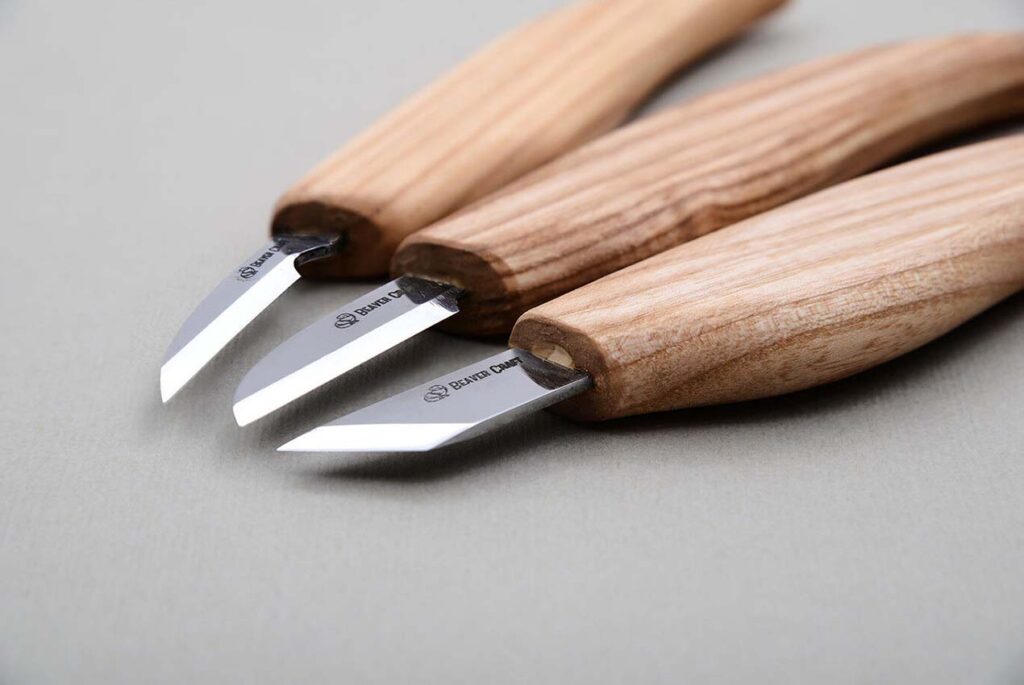
Carving knife
Wood carving knives are the main tools for smoothing, chopping, and circle cutting. There are different types of knives, the most common are:
- Chip carving knife- a knife with a short blade, usually no longer than 1.5 inches, ideal for cutting shavings and triangles in wood. Its curved shape makes it easy to cut on a flat surface.
- Sloyd knife- a sliding knife is the most common type of knife that can be classified as a wood carving knife. Features a 2-3 inch blade and rounded handle for easy handling. This knife can quickly cut through large pieces of carved wood and is ideal for rough carving and shaving.
- Bench knife – once you’ve carved roughly with a sloyd knife, you need a smaller, more precise tool for the finer details. It’s only 1 to 2 inches long, giving you more control over your carving projects.
- Hook knife- a wood carving knife, is a carving knife with a rounded bottom that you can use to make curved cuts or shovel wood. Due to its shape, it is mostly used to make spoons. Therefore, they are also called spoon knives.
- Skew knife- a serrated knife or micro knife is useful when you are working with a very small piece and need something even more precise than a utility knife. A bevel knife is used for vertical cuts when the surface is limited.
There are other knives you can use for whittling and carving, such as pelican knives and specially-made tools, but these five will likely cover all your needs as a beginner.
If you like pecking or hacking, look no further. However, if you like embossing or circle engraving, you’ll love what’s next.
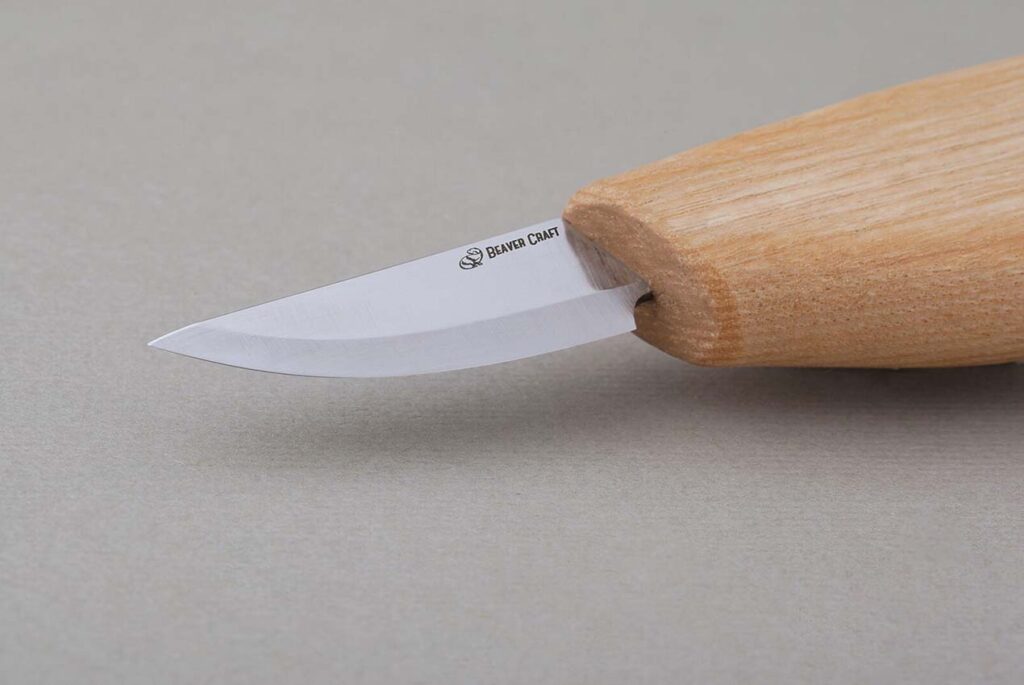
Wood carving chisels and mallet
Wood carving chisels are very efficient tools and are perfect for large wood carving projects. You can remove large pieces of wood in one fell swoop, speeding up the normally lengthy process.
Chisels are also very common among woodworkers, so you probably already have them. There are two types of chisels used in wood carving gouges: the regular carpenter’s chisel (also called a #1 chisel) and the miter chisel (also called a 1S chisel).
A skew chisel also has a flat cutting edge, but is angled or beveled and is referred to as a 1S angle chisel. Both types of chisels are used on the edge of the tree rather than on a flat surface.
Ideally, you’ll need at least one of each, or buy a starter kit like the VonHaus 16pc that also comes with a mallet. If you prefer to work quietly when carving wood, it is best to use a rubber mallet such as the Tekton 16oz.
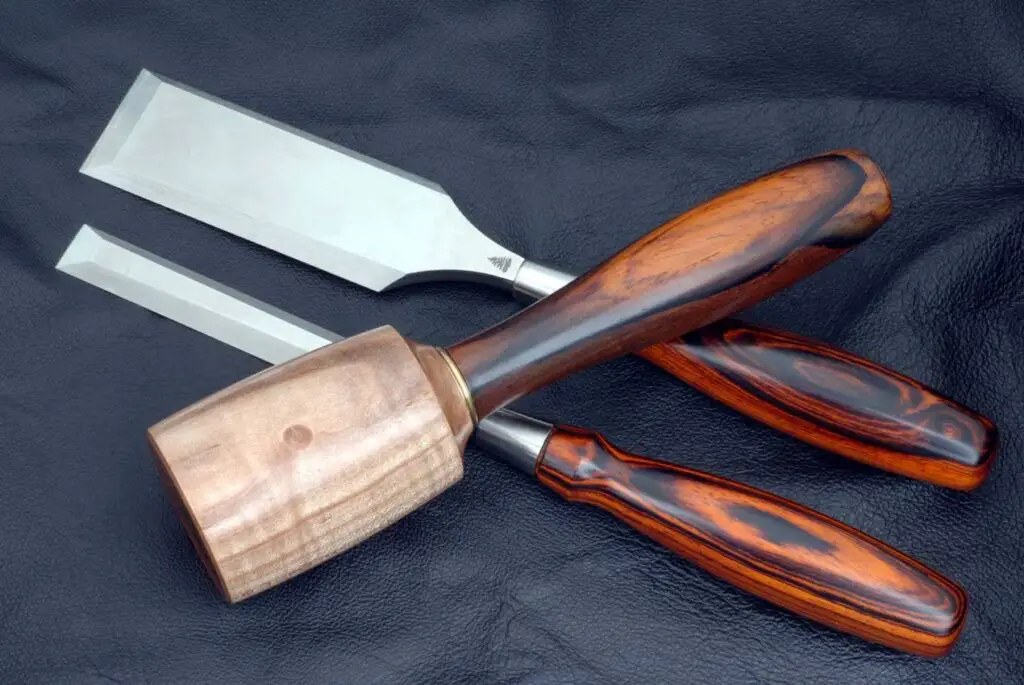
Can I make my own wood carving tool?
You can make your own wood carvings tools like chisels, carving knives, hammers, and chisels. The best part is that making these tools requires no technical skills and can be made from everyday objects.
The materials and tools you will need to make your carving tool may vary slightly depending on the type of carving tool you want to make.
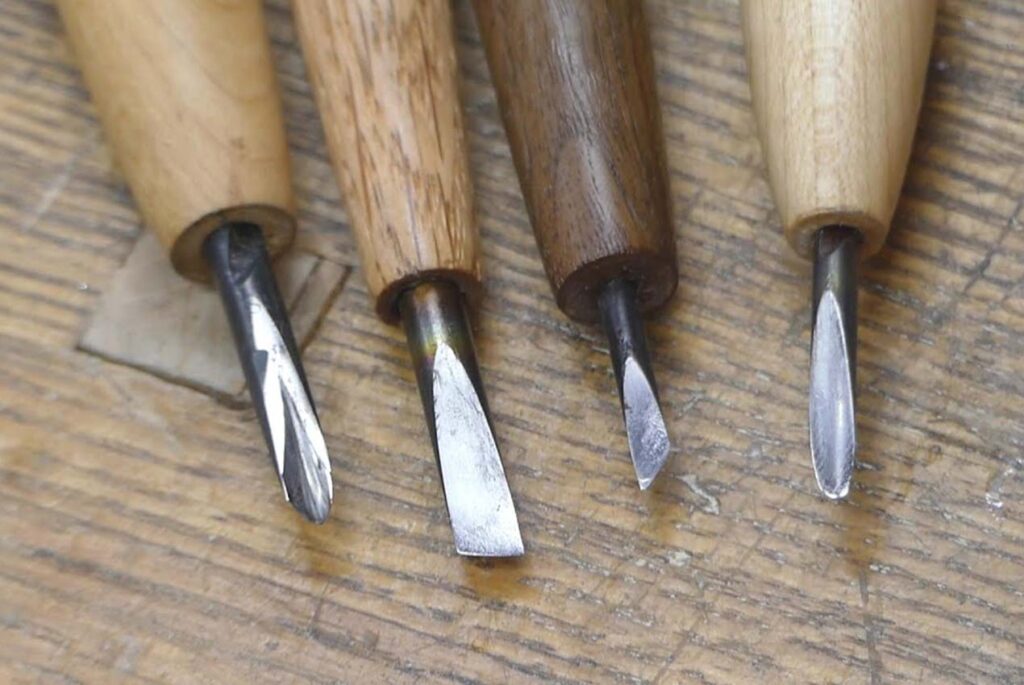
How to make a carving knife
To make a carving knife, you need the following materials and tools:
Materials
- Wood (hardwood is recommended)
- 1095 steel blade
Tools
- A hammer
- A saw
- A vice
- An Ax
- A Wood carving knife.
Method
After choosing the knife and wood for work:
- Prepare the knife and wood by shaping the wood thinly and sharpening the blade.
- Drive the blade into the wood.
- After that, draw the shape of the wood and the blade on a piece of paper.
- Shape the knife handle and oil the knife.
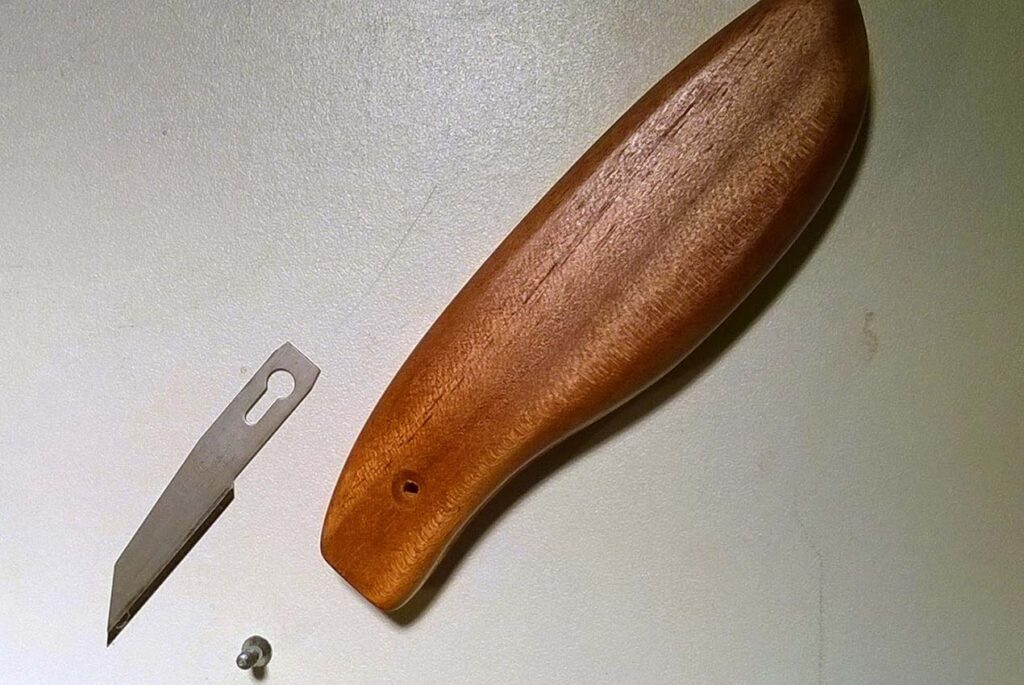
How to make a mallet
Materials
- Oak
- Galvanized pipe
- Tool
- Glue
- Screws
- Nails
Method
First, cut a wooden dowel to the required length and separate the end of the pipe. Then loop the end of the pipe around the dowel and fasten the dowel with wood screws and secure the nail joint with glue along the seams and cracks.
Leave the glue on for 24 hours. Then sand away any excess glue, chips, or burrs. Finally, bake at 662 °F for 2 hours.
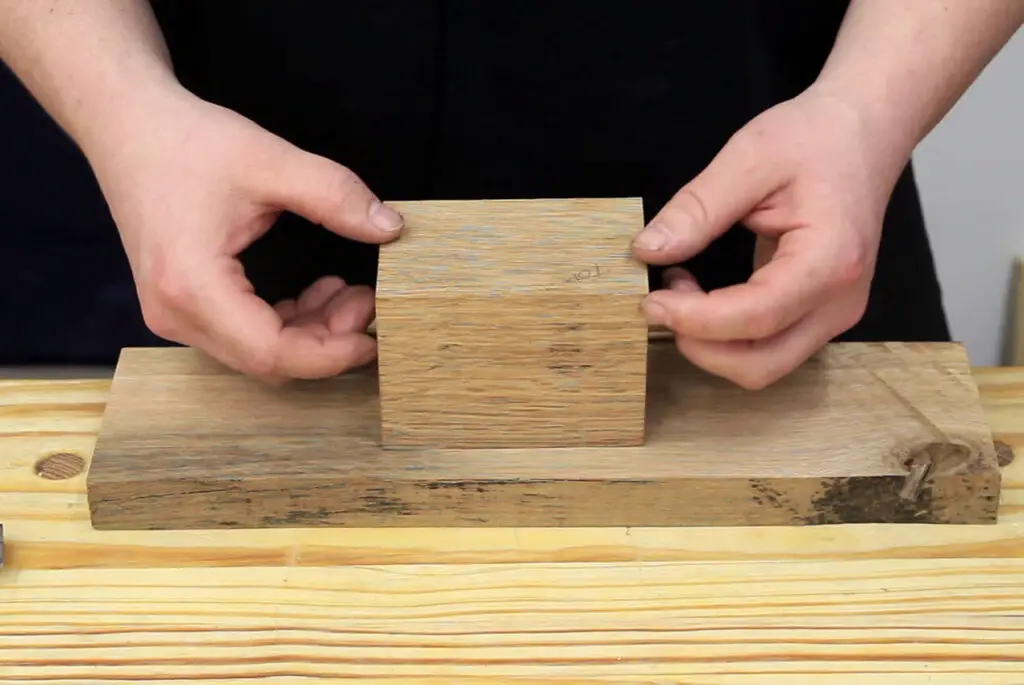
Safety tips for making carving tools
- Always use protective equipment when working. Safety glasses prevent sparks and flying metal from damaging your eyes.
- Always keep a fire extinguisher nearby and be careful. Wear flame-retardant clothing and make sure you wear closed-toed shoes.
- If you are rigging, make sure there is adequate ventilation. Installing carbon monoxide detectors is also a good idea.
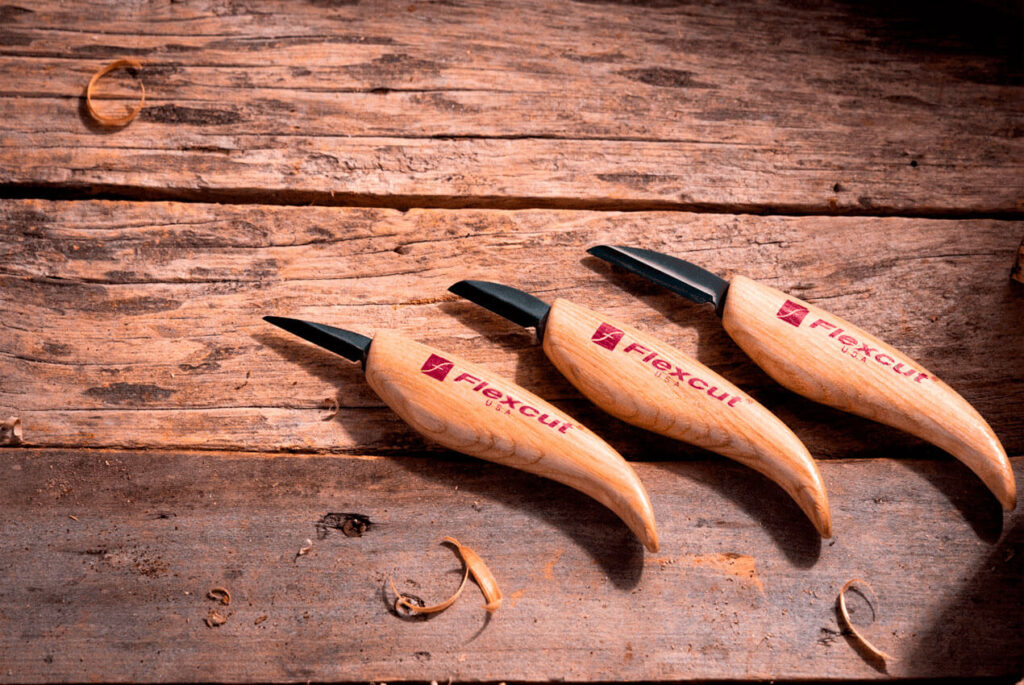
FAQ
What can I use if I don’t have a knife for my carving?
Knives have long, narrow blades and must be sharp to do their job properly. However, what they do can also be done with a chef’s knife or utility.
Can you use a knife to carve wood?
Walnuts and fruit woods work best, but anything “green wood” or freshly cut with lots of moisture will cut well, even hard, porous woods like oak.
A utility knife can be used in conjunction with a carving blade for light carving, for example, for creating small patterns and shapes on a piece of wood.
Is wood carving difficult to learn?
Now that you are familiar with the various wood carving techniques, the best wood for beginners, and the tools, you may be wondering if and when you can master it all.
Fortunately, wood carving is easy to learn. The best place to start as a beginner is engraving. Not only do you need minimal tools, but you don’t have to do the job well.
There are also many free templates on the Internet with detailed instructions to help you get started. But like everything in life, you’ll only be as good as your time and practice.
Which wood is better for carving?
Soft woods such as basswood, pine, cedar, aspen, walnut, and cork are known as the best and most durable woods for wood carving.
In addition to softwoods, hardwoods such as spruce, birch, maple, cherry, black walnut, and apple are also great for wood carving.
How long does it take to learn how to carve wood?
How long it takes to learn wood carving depends on your skill. If you practice well and learn new skills and techniques quickly, it will take less time to learn carving wood.
It depends on how much you like wood carving.
As a full-time woodworker, I know that there is no exact time frame for learning wood carving, as there is always something new to learn. The world of carving is full of mysteries.
What should I cut as a beginner?
You can carve a lot of great things as a beginner, but perhaps the easiest is the tablespoon. You can complete it in less than two hours, and all you need is a whittling knife and a hook knife.
Wood carving can boost your confidence even as a beginner, and it’s not as hard as it seems.
So grab whatever scraps of wood you have or whatever log you can find outside and start planning.
What is the easiest thing to carve in wood?
As a beginner, I think you should start with some simple classic patterns.
And one of them is the easiest to cut out carve wood – a heart cut.
It is also known as one of the easiest wood carving projects. When making a wooden heart, you can learn how to create a curved shape by adding small cuts throughout the piece of wood.
There are many wood carving projects for beginners that you can try to improve your knowledge and learn many new wood carving tricks and techniques.
Conclusion
In this post, we have explained how to start wood carving and what you need to know before starting wood carving.
In addition, we also examined the types of embossing, embossing tools, and their applications.
Finally, we’ve answered all the common questions beginners have before starting wood carving as a hobby or business.
But most importantly, we learned how to start wood carving without any problems and get on with it.
I recommend that you keep learning and practicing until you become a wood carving pro.

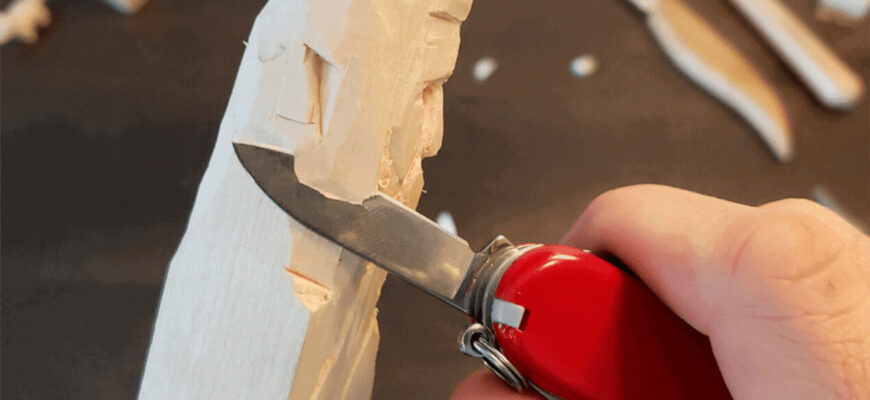
![Sapele vs. walnut wood [5 main differences] Sapele Vs. Walnut Wood: Top 5 Differences & Best Guide](https://bestwoodforcarving.com/wp-content/uploads/2024/01/wood-53-335x220.jpg)
![Mango wood furniture pros and cons [9 tips] Mango wood furniture pros and cons + 9 tips before you buy](https://bestwoodforcarving.com/wp-content/uploads/2024/01/wood-51-335x220.jpg)
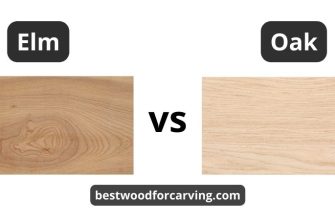
![Which advantages and disadvantages of hickory wood? [8 factors] Top 8 Disadvantages Of Hickory Wood: Best Helpful Guide](https://bestwoodforcarving.com/wp-content/uploads/2024/01/wood-38-335x220.jpg)
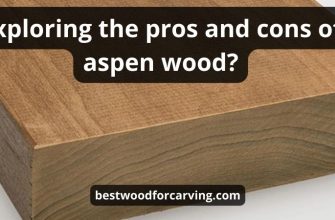

![How Long Do Wood Pellets Last? [6 Essential Insights Unveiled] How long do wood pellets last](https://bestwoodforcarving.com/wp-content/uploads/2023/12/How-Long-Do-Wood-Pellets-Last-6-Essential-Insights-Unveiled-2-335x220.jpg)
![Tung oil vs polyurethane [4 main comparison factors] Tung Oil Vs Polyurethane: Top 4 Factors & Best Helpful Guide](https://bestwoodforcarving.com/wp-content/uploads/2023/12/wood-14-335x220.jpg)
![Is tung oil flammable? [7 Preventive measures] Is Tung Oil Flammable: Top 7 Safe Tips & Best Guide](https://bestwoodforcarving.com/wp-content/uploads/2023/12/What-is-a-Wood-Planer-3-335x220.jpg)